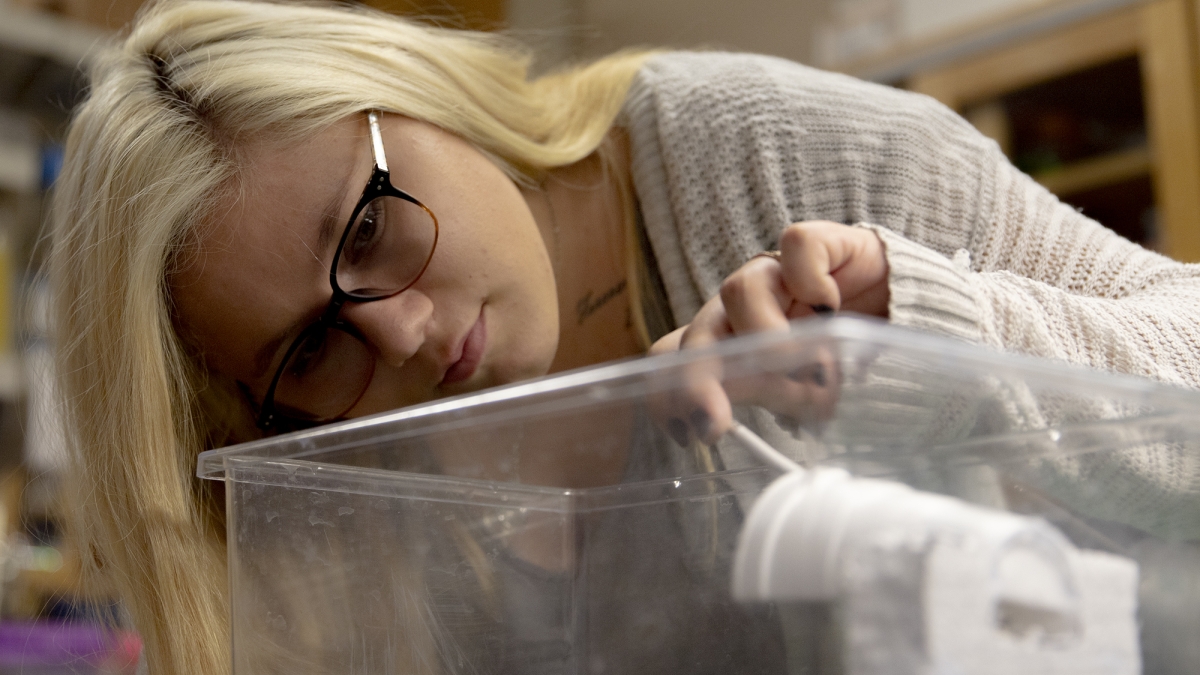New College research program gives local students world-class experience
New summer program opens scientific doors for undergraduates

Glendale Community College student Marissa Heeb maintains a population of black widow spiders as part of her summer research program on ASU's West campus. Photo by Amber Orquiz/New College
Black widow spiders have been daily companions for Marissa Heeb this summer on Arizona State University’s West campus. “It's been weirdly cool even though they're kind of creepy, but it's been a lot of fun.”
Heeb is one of eight undergraduate scholars performing graduate-level research through the New College Environmental Health Science Scholars (NCEHSS) program this summer.
“The black widow’s (DNA) genome is not mapped, unlike other organisms, so it's known the black widow is a big question mark. So, we're trying to fill in the spaces and figure out exactly what that looks like,” Heeb said.
Research experience is critical for furthering students’ science careers.
“There are many summer research experiences around the country that students would apply for and then they would travel across the country to participate in those research experiences,” said Pamela Marshall, a professor in the School of Mathematical and Natural Sciences in the New College of Interdisciplinary Arts and Sciences. “What we found was that there are actually a large number of students in Maricopa County who can't leave Maricopa County for whatever reason.”
Marshall and colleague Jennifer Hackney Price collaborated to create competitive research opportunities for place-bound students.
“That's when we decided that, ‘Hey, we can come up with a summer program where students get that same research experience but they can still fulfill their other (family or work) obligations,’” Hackney Price said.
The result is a five-year grant funded by the National Institutes Health, the NCEHSS program. The summer program provides 10 weeks of intensive classroom instruction and lab research opportunities for promising students unable to pursue similar opportunities elsewhere. Scholars also receive a $4,000 stipend for participating.
“I feel like we are really helping our students and also helping students that in live in the West Valley. We have not only ASU students, we also have students that are from the area community colleges and I feel like we're really making a difference in their lives,” said Hackney Price, also a professor in the School of Mathematical and Natural Sciences in the New College of Interdisciplinary Arts and Sciences.
Scholar Jacqueline McCarter attends Phoenix Community College and is transferring to ASU’s New College this fall.
“My home is about 25 minutes from this campus so it makes it extremely convenient," she said. "If I had to travel outside of the state for this program, I would not be able to do it as a lot of us here do have families, we have jobs, different responsibilities that definitely hinder us from being able to travel outside of the states like some people do.”
Video by ASU New College
Just weeks into the summer program, McCarter and her lab partner made a dramatic discovery.
“They actually identified a cell phenomenon that nobody has ever seen before and so we're taking my research in a new and different direction than we ever have before,” said Marshall, who was their mentor. Marshall said the discovery has implications for better understanding and treating heart disease.
“This program has surpassed anything that I originally had imagined for myself as far as all the invaluable information that I've learned along the way,” McCarter said of her experience this summer.
As the inaugural year of this program concludes, participants will present their research findings through a poster session.
“Another unique aspect about our program is we are asking them to invite their families, their significant others, if they're community college students or transferred from community college, invite their faculty, their high school teachers, anybody that they want. We want to make it a very friendly, welcoming, open type of experience,” Marshall said.
For Heeb, the opportunity could have lasting effects: “It's been really eye-opening for me personally. I came into this and didn't know exactly what my plan was for the future. Now with the guidance of Dr. Hackney Price, I feel like I know what I want to do with my life.”
The professors are already looking forward to recruiting next summer’s cohort.
“For next year we anticipate that the applications will be up late in the fall semester. Students will apply with the application due sometime between January and February,” Marshall said.
Program criteria and applications for next summer’s program will be available at newcollege.asu.edu/ncehss.
More Science and technology

SpaceHACK highlights student solutions to environmental challenges, digital divide
By Adrianna Nine About 250 students from around the world convened online and at Arizona State University on March 22 for the…

New AI for a new era of discovery
As the legend goes, in 1665, Sir Isaac Newton sat in his garden at Woolsthorpe Manor in England and looked on as a lone apple…

ASU receives 3 awards for research critical to national security
Three researchers in the Ira A. Fulton Schools of Engineering at Arizona State University have received grant awards under the …